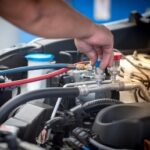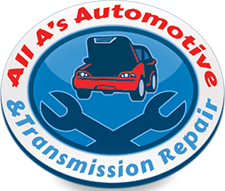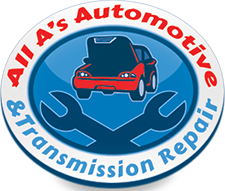Recharge Your Auto A/C: Cooling Down Your Car This Summer

 Summer has arrived in Midland, MI, bringing warm temperatures and oppressive humidity. Did you know that running your car’s air conditioning not only lowers the cabin air temperature, it also reduces moisture levels? That sounds like a win/win to me. However, if the refrigerant level in your auto HVAC is low, your air conditioning system may need an auto A/C recharging service to get the cold air flowing again.
Summer has arrived in Midland, MI, bringing warm temperatures and oppressive humidity. Did you know that running your car’s air conditioning not only lowers the cabin air temperature, it also reduces moisture levels? That sounds like a win/win to me. However, if the refrigerant level in your auto HVAC is low, your air conditioning system may need an auto A/C recharging service to get the cold air flowing again.
What Is Auto A/C Recharging?
The substance inside auto HVAC systems that produces the wonderfully cold air out of the vents is called refrigerant. Inadequate levels of refrigerant result in ineffective air conditioning (including more humidity) in your car’s interior. Reduced airflow and warm air are signs your vehicle may need an auto A/C recharging service. Licensed auto repair technicians generally perform auto A/C recharging. They check for refrigerant leaks, make the necessary repairs, and refill the system with the correct type of refrigerant.
Auto HVAC Refrigerant Types
Just as automobile body styles have changed over the years, so have the types of auto HVAC refrigerants. Once the impact of millions of vehicles driving around daily became apparent, government agencies made adjustments to mitigate environmental damage and ensure public safety. You can see the evolution of refrigerant types regarding safety, efficiency, and potential dangers.
R-12
Initially, vehicles used R-12 in their air conditioning systems. R-12 (dichlorodifluoromethane) is a colorless gas branded as Freon™️ (or Freon-12). It is a chlorofluorocarbon halomethane (CFC) used as a refrigerant in automobiles equipped with an air conditioning system. Its manufacture was banned by the Montreal Protocol (beginning in 1996) due to concerns over the damage it did to the ozone layer and global warming. Vehicle manufacturers shifted from R-12 to R134a.
R-134a
In the early 1990s, R-134a replaced R-12 as the preferred refrigerant for auto HVAC applications. While R-134a does not have an ozone depletion potential (ODP) like R-12, it does have a high global warming potential (GWP). GWP chemicals are referred to as ‘greenhouse gases’ and contribute to global warming. Some older model vehicles may still have air conditioning systems using R-134a.
R-1234yf
R-1234yf (tetrafluoropropene) is a hydrofluorocarbon (HFC) refrigerant that gained popularity as a replacement for R-134a in the mid-2000s. Auto manufacturers shifted to using R-1234yf in new vehicles primarily due to environmental regulations aimed at reducing the global warming potential (GWP). R-134a has a GWP of 1,430, while R-1234yf has a GWP of 4 and is non-ozone depleting. These factors make it significantly less harmful to the environment than either R-134a or R-12. R-1234yf is still used widely in most vehicles produced today.
R-744
R-744 is pressurized CO2 used as a refrigerant. With increased pressure, R-744 absorbs heat and releases it under reduced pressure. It has a global warming potential (GWP) of 1 and an ozone-depleting potential (ODP) rating of 0. Unfortunately, R-744 is not effective in hot climates and struggles to perform in some combustion engine vehicles without significant engineering alterations to the air-conditioning system. R-744 may be the refrigerant of the future, but more research is required.
Refrigerant Safety
Not all refrigerants are created equal, and in fact, most people should leave the handling of them to professionals. In some cases, owning or misusing refrigerants is illegal. Recharging your auto A/C is a process that requires specific safety precautions.
- R-12 is rarely used in vehicles anymore, except in classic cars that contain factory-original air conditioning systems using Freon™️. The use of R-12 is currently strictly regulated. Only certified technicians with a 608 or 609 certification are authorized to purchase and handle this refrigerant type.
- R-134a is known for excellent thermal stability, non-corrosiveness, and low toxicity. However, it is a potent greenhouse gas regulated under international climate agreements. It must be handled with care and not released directly into the environment.
- R-1234yf is not considered a hazardous substance, but it requires proper handling during air conditioning system service or maintenance. Technicians must wear personal protective equipment (PPE) to avoid direct contact with the refrigerant, which can cause frostbite. It’s also worth noting that R-1234yf is flammable under certain conditions. It also requires specific methods for safe collection, recycling, or disposal.
- R-744 is non-flammable, however, CO2 displaces oxygen, so a large leak could pose a health risk in enclosed areas. Make sure to store pressurized CO2 canisters in a cool, well-ventilated area.
Air Conditioning System Service in Midland, MI
All A’s Automotive & Transmission Repair is a family-owned and operated business in Midland, MI. We offer complete automotive services for all foreign and domestic vehicles. If you suspect low refrigerant levels in your auto A/C, our experienced service technicians can help. We will inspect, diagnose, and repair your air conditioning system quickly to get you back on the road in comfort.
Schedule Auto HVAC Service
Call us at (989) 631-4672 or visit us online to schedule your auto A/C Recharging appointment today.
Posted in: Auto A/C
Leave a Comment (0) ↓
